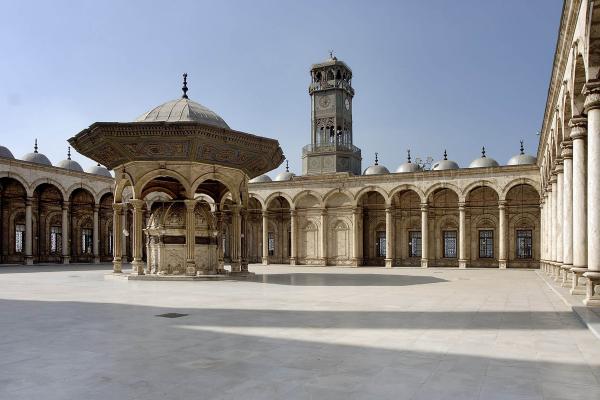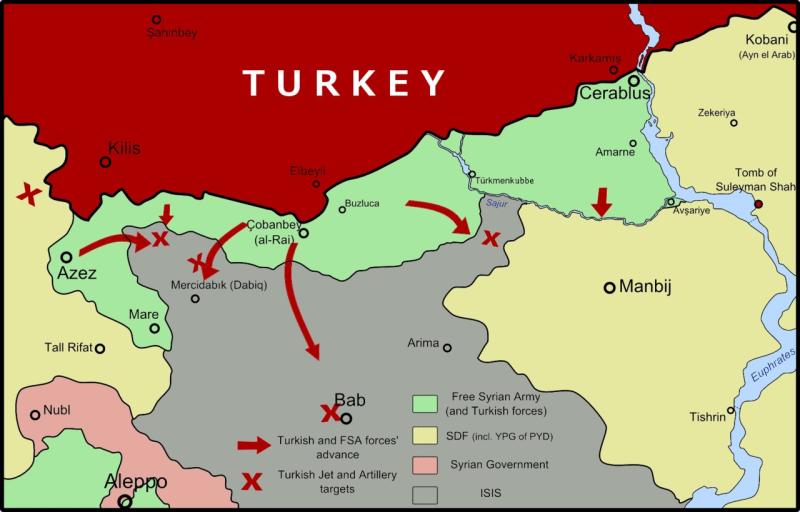A War Among Friends

By Alex Rand
The age-old adage goes “the enemy of my enemy is my friend”. However, the United States now finds itself in a situation of “the enemy of my friend is still my friend”. In the past several months, the US strategy in Syria has been under tremendous strain due to the infighting between two of its most important allies in the region; Turkey and the Kurdish militias of northern Syria.
On August 24th, Turkish-backed Syrian rebel groups launched an offensive in tandem with Turkish armed forces to retake the border town of Jarablus and the surrounding region [#1]. The operation, dubbed ‘Euphrates Shield’, quickly achieved its goal of removing the so-called “Islamic State” from 91 kilometers of Turkey’s southern border [#2]. The Turkish intervention is the most involved the country has been in the Syrian conflict since it began 5 years ago. It soon became clear, however, that Turkey had an ulterior motive for committing its military to the Syrian fray.
Within days of intervening into northern Syria, the Turkish military was shelling and engaging in armed confrontations with Kurdish YPG, or People’s Protection Units, which are backed by the US [#3]. The YPG are the primary Kurdish militia operating in northern Syria. Officials from the Pentagon were quick to release statements condemning the clashes and encouraging both sides to de-escalate and focus on the common enemy; the so-called “Islamic State” [#4].
But the question for many at home is this; why are the Turks and Kurds fighting one another? Shouldn’t the Turkish military and US-backed groups be fighting ISIS rather than each other? In order to answer those questions, it is necessary to take a look at the complicated and violent history of Turkish-Kurdish relations.

The Turkish Offensive into Northern Syria, August 28 2016. Kurdish positions are shown in yellow. Turkish & FSA positions are shown in green. “Cerablus” is the Turkish spelling of Jarablus. Credit to Berkaysnklf via Wikimedia Commons, public domain, CC BY-SA 4.0
The Backdrop
The Kurdish people represent one of the largest nationless groups in the world [#5]. The Kurdish population is between 25 and 35 million people, and is spread across Armenia, Turkey, Syria, Iraq and Iran [#6]. The largest concentration of Kurds is found in southeastern Turkey, where approximately 15 million reside [#7].
An independent Kurdish nation was provided for in the Treaty of Sevres in 1920. However, a Turkish victory in its war for independence resulted in the Treaty of Lausanne in 1923, which established the modern borders of Turkey and did not provide for a Kurdish state, leaving the ethnic group as a minority in several states across the Middle East [#8]. Any attempt by the Kurds living in Turkey to break away and establish an independent Kurdish state were ruthlessly repressed over the next several decades [#9]. There were several attempts in the 1920s and 1930s to establish an independent Kurdish state which were quashed by the Turkish military [#10].
Rise of the PKK
In the early 1980s, a new stage of Kurdish separatism began in Turkey. The Kurdistan Workers’ Party, or PKK began a guerrilla war against the Turkish government [#11]. This guerrilla war has claimed more than 45,000 lives [#12] and has lasted for several decades. A cease-fire between the PKK and the Turkish government was reached in 2013 and lasted until mid-2015 when the Turkish military bombed a PKK instillation within Iraqi Kurdistan [#13]. Since that time violence in southeastern Turkey has begun to escalate again [#14]. It is important to note that the PKK is classified as a terrorist group by the US and the EU [#15]
One of Turkey’s primary policy goals is to subvert the establishment of an autonomous or independent Kurdish state. The Turkish government is already alarmed by the existence of the semi-autonomous Iraqi Kurdistan [#16] and fears that potential Kurdish independence or autonomy outside of Turkey may incite further separatist movements within its borders and compromise its territorial integrity [#17].
The Turkish-Kurdish Tensions
The YPD is the primary Kurdish political party operating in Syria [#18]. It was founded as an offshoot of the PKK in 2003 [#19]. The YPD’s armed units, referred to as the YPG, have been an incredibly effective fighting force in north and northeastern Syria over the past several years. They have been so effective, in fact, that they have managed to establish an area of Kurdish control that runs along nearly the entirety of Turkey’s southern border, with exceptions in several areas [#20]. These Kurdish areas, known collectively as Rojava, have been separated by the border town of Jarablus, which was occupied by ISIS up until recently [#21].
This nearly contiguous de facto Kurdish region on Turkey’s southern border is the primary reason why the two parties are fighting one another. The YPG, in an effort to unite Rojava, seized the crossroads at Manbij, just 25 miles south of Jarablus, earlier in August [#22]. The intent of the YPG was to seize Jarablus and then al-Bab in order to connect Rojava with Afrin, a pocket of Kurdish control in northwestern Syria. This move alarmed the Turkish government. Were a united Kurdish territory allowed to exist along its southern border, separatism at home could intensify [#23]. The Turkish government, along with allied rebel groups, quickly seized Jarablus in order to block the Kurdish advance, and ordered the YPG to retreat across the Euphrates river. Kurdish forces that have remained in the area around Manbij have come under fire from Turkish artillery and air power [#24].
Between a Rock and a Hard Place
This situation leaves the United States in a tricky position. Turkey has been an immensely important ally in the Middle East over the past decades. Turkey has played host to US air power in the region, allowing airstrikes to be flown from its southern airbases. The US can’t compromise their relationship with Turkey, but it can’t abandon one of its most effective Syrian proxies either. The YPG makes up the bulk of the Syrian Democratic Forces (SDF), which is a coalition of resistance groups backed by the US [#25]. The United States finds itself trying to balance the competing agendas of both parties while at the same time attempting to focus them on fighting ISIS [#26].
The US has urged Kurdish forces to pull back across the Euphrates river while also imploring both sides to focus on the so-called “Islamic State” [#27]. Ash Carter, the current US Secretary of Defense, has stated “we’ve called on both sides to not fight one another,”. The Pentagon has also expressed its concerns, releasing a statement that said “uncoordinated operations only provide room for ISIL to find sanctuary and continue planning attacks against Turkey, the SDF, the United States, and our partners around the world” [#28]. The US has engaged both sides in an attempt to de-escalate the conflict [#29], but the outcome remains uncertain. Should the Kurds ignore Turkish and American warnings, their westward offensive could further strain US-Turkish relations.
Haidar Khezri, a senior fellow at the Center for the Study of the Middle East (CSME) and Adjunct Assistant Professor of the Department of Eurasian Studies at the University of Indiana, Bloomington had some thoughts to share concerning the position of the United States.
“First, I think the US can push Turkey and the Turkish-Kurds in general, and PKK in particular, to come back to the negotiating table and restart the ceasefire,” said Mr. Khezri.
“The PKK has direct influence on Syrian Kurds,” he added, the implication being that should the PKK accept a ceasefire, then so too would the YPG militias, effectively defusing the situation.
Mr. Khezri continued, saying that the “United States needs to make clear to Turkey that its intervention must be limited, this is not only out of respect for Syrian Kurds, but also to prevent any further clashes between these two American partners.” Turkey has not made clear how long it intends to stay in northern Syria.
Implications
The Kurdish-Turkish confrontations in northern Syria do not spell well for the future of the Syrian Civil War, an already exceedingly complicated conflict. The United States may find itself being forced to choose between one ally or the other depending on how the opposing groups conduct themselves. The US requires Turkish cooperation in order to continue its air campaign against ISIS, whereas they also require the SDF (which is comprised primarily of YPG units) in order to strike south toward Raqqa, the self-proclaimed capitol of the so-called “Islamic State”.
The fact of the matter is that the stability of the US-backed coalitions lies in the hands of the participants of those coalitions. “If Turkish intervention remains limited then the tensions between the Turks and the Kurds will remain periphery,” said Mr. Khezri. Should they decide to focus on their individual agendas, however, then perhaps the situation could further degrade.
Regardless of how the Syrian Civil War ends, Mr. Khezri predicts that Turkish-Kurdish tensions will remain. The root of the problem, an autonomous or independent Kurdistan, will remain the true point of contention until it is resolved, peacefully or otherwise. The current instability in the region, along with tremendous territorial gains in recent months marks the best opportunity for autonomy or independence for the Kurdish people than at any time in recent history. Mr. Khezri predicts that the Kurds will continue to act in their own self-interest, and may continue with their campaign to unite western Kurdistan. Their ambition, however, could intensify intervention from Turkey, further putting US policy in the region at serious risk of failure.
Editorial Update: At the time of this article's publishing the Turkish military, its FSA allies and SDF forces were simaltaneously advancing on the city of al-Bab [#30].
A special thanks to Mr. Haidar Khezri, a senior fellow at the Center for the Study of the Middle East and an Adjunct Assistant Professor in the Department of Eurasian Studies for his insights and to the Center for the Study of the Middle East at Indiana University, Bloomington.
Here are some additional videos on the Kurdish people in history, and the broader context of the Middle East:
TEDx Talk on The Kurds: https://www.youtube.com/watch?v=Wiqhu3Q5NpE&feature=youtu.be
Kurdistan in Context 1: https://www.youtube.com/watch?v=ho04eWr4GFg
Kurdistan in Context 2: https://www.youtube.com/watch?v=iO8Oqz5k7Jc
Kurdistan in Context 3: https://www.youtube.com/watch?v=GgRB0wAlUdU
References
[1] http://www.understandingwar.org/backgrounder/turkish-incursion-northern-syria-signals-turning-point-anti-isis-fight
[2] http://www.aljazeera.com/news/2016/09/syria-war-isil-driven-turkey-syria-border-160904164425932.html
[3] http://www.nytimes.com/interactive/2015/08/12/world/middleeast/turkey-kurds-isis.html
[4] http://www.bbc.com/news/world-middle-east-37212256
[5][6] [8][9] http://www.bbc.com/news/world-middle-east-29702440
[7] http://www.france24.com/en/20150730-who-are-kurds-turkey-syria-iraq-pkk-divided
[10] http://uca.edu/politicalscience/dadm-project/middle-eastnorth-africapersian-gulf-region/turkeykurds-1922-present/
[11] [12][13][14][16][17][23] http://www.worldaffairsjournal.org/article/trouble-turkey-erdogan-isis-and-kurds
[15][18] [19] http://www.aljazeera.com/indepth/interactive/2015/07/major-kurdish-factions-150728150924667.html
[20][21] http://www.wsj.com/articles/syrias-kurds-have-carved-out-a-statelet-adding-new-snags-to-a-complex-region-1472661321
[22][24][26][27][29] http://www.wsj.com/articles/turkey-send-more-tanks-into-syria-as-kurds-pull-out-of-manbij-1472129794
[25] http://www.aljazeera.com/news/2016/08/syria-turkey-targets-kurdish-forces-south-jarablus-160827134358184.html
[28] http://www.usnews.com/news/world/articles/2016-08-29/turkey-warns-of-more-strikes-if-syrian-kurds-dont-retreat
[30] http://www.al-monitor.com/pulse/originals/2016/09/syria-battles-al-bab-manbij-sdf-isis-withdrawal-aleppo.html
